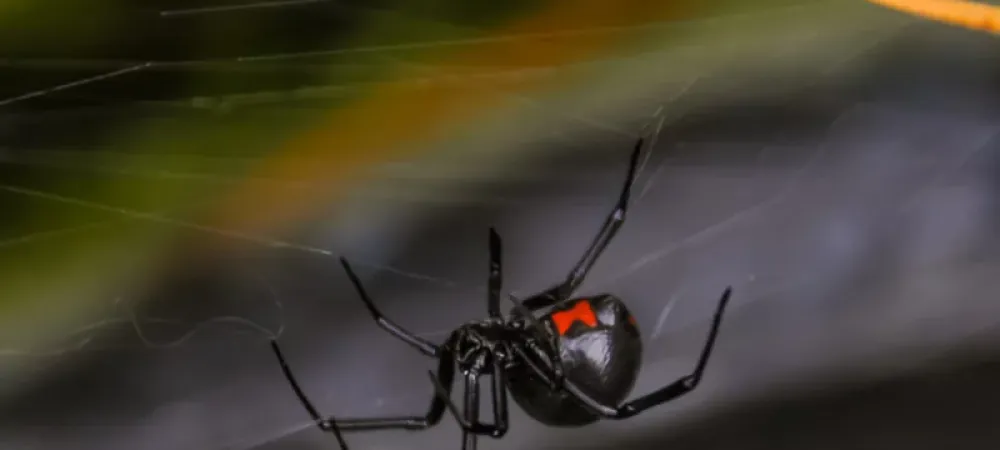Five Hair Raising Spiders Found in the Garden State

The next time you are sitting around the campfire telling ghost stories and eating s’mores, be on the lookout for these hair-raising spiders. We’re not talking about the ones that come in your Halloween decor. Here in New Jersey, we have tons of spiders. Fortunately, most of them are not deadly to humans. Learn about the most disturbing-looking spiders we have here in the garden state and the two that are venomous.
Wolf Spider
This scary-looking dude will scare the pants off of anyone! With its hairy nature, it is often mistaken for the tarantula, but never fear, this spider is not venomous. It is quite large, usually brown and black with grey coatings. It has alien-like eyes with four small eyes on the bottom row and two bigger eyes straight above.
As if that’s not enough, they still have two large eyes on top of their head. Instead of spinning a web to capture their game, they hunt their dinner on the move, like wolves. They live in burrows and tend to pounce on their prey when something crawls past and stirs their appetite. In the home, they are most likely to be found in basements, crawlspaces, and near doors and windows. While they will bite in self-defense, they are not known to be aggressive. Even if you find yourself on the receiving end of wolf spiders, the good news is that they are not deadly.
Yellow Sac Spider
Yellow sac spiders are fairly common and found all over the United States. While they account for more spider bites on humans than any other spider, they are actually very tiny. Yellow sac spiders are usually pale yellow or cream-colored with a dark brown jaw. They are nighttime feeders and feed on small insects and sometimes other spiders. They are mostly outdoor spiders but will occasionally enter buildings and breed inside. This is why they are most commonly seen at night crawling on walls and across ceilings. They sometimes even crawl onto people sitting on a couch or lying in bed. Fortunately, the yellow sac spider bite is not dangerous but can cause days of itching, swelling, and redness.
Jumping Spider
These furry creatures are commonly mistaken for the black widow spider, due to their compact black bodies with relatively short legs. Jumping spiders range in size from one-eighth of an inch to three-fourths of an inch. They are typically covered with dense hair or scales that are brightly colored. These athletic beings, however, can also be brown, tan, or gray in color. They have excellent daytime vision and are able to detect and react to a movement that occurs up to a foot and a half distance. This may be due to the odd layout of their eyes. With eight eyes in three rows, the front row has four eyes and one huge pair right in the middle. Want to seek out this freaky-looking spider? They are most commonly seen hopping along with ceilings and windowsills. Lucky for us, while the jumping spider bites, it is not venomous.
Black Widow
Beware of the black widow! Just the drop of the name makes your skin crawl. Of all the spider species in North America, the black widow is probably the most widely recognized. Most people know the black widow by its iconic red hourglass under its abdomen. They are the deadliest spider. Its venom is 15 times worse than that of a rattlesnake. But don’t worry. Humans aren’t really part of the black widow’s diet. They spin their messy webs to capture mostly flies, mosquitoes, grasshoppers, beetles, and caterpillars. The bristles on their hind legs are used to cover their prey with silk once it has been trapped. Don’t spend too much time fretting over the black widow. They are mostly nocturnal and prefer to stay hidden.
Brown Recluse
Another spider known for its bite is the brown recluse. These spiders are brown and identified by the black mark on their abdomen that looks like a violin. Their natural habitat is outside in gardens. In the winter, however, they like to hide in the darkest areas of your home such as the basement, attic, garages, trash cans, and attics. Though they aren’t usually aggressive, they will bite if they feel threatened. The infamous bite of a brown recluse can cause skin cells to die in the area surrounding the spider bite, known as necrosis. This can lead to infection and, in rare cases, death. If you are bitten by a brown recluse or a black widow, seek medical attention immediately.
Learning about spiders may be cool, but most of us are not comfortable hanging out with them. That is why, we offer a highly effective Perimeter pest control program that will prevent and eliminate pests such as spiders, mites, crickets, roaches, ants, and more. Our certified, licensed technician will inspect the perimeter of your home and secure all access points. Contact Harvest Lawn Care now.